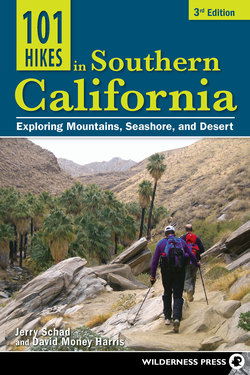Читать книгу 101 Hikes in Southern California - Jerry Schad - Страница 27
На сайте Литреса книга снята с продажи.
ОглавлениеHIKE 14
Placerita Canyon
Location: Santa Clarita
Highlights: Wooded ravines, waterfall, and historically interesting features
Distance: 5.0 miles (out-and-back)
Total Elevation Gain/Loss: 700'/700'
Hiking Time: 2½ hours
Optional Maps: USGS 7.5-minute Mint Canyon and San Fernando
Best Times: October–June
Agency: PCP
Difficulty: Moderate
Trail Use: Dogs allowed, good for kids
Barely 10 minutes’ drive from northern San Fernando Valley and the sprawling suburban city of Santa Clarita, Placerita Canyon Park nestles comfortably at the foot of one of the more verdant slopes of the San Gabriel Mountains. A very civilized nature center housing exhibits on local history, pre-history, geology, plants, and wildlife complements the park’s wild backcountry sector (the subject of this hike).
Placerita Canyon’s fascinating history is highlighted by the discovery of gold there in 1842. That event, which touched off California’s first (and relatively trivial) gold rush, predated by six years John Marshall’s famous discovery of gold at Sutter’s Mill in Northern California. By the 1950s, Placerita Canyon had become one of the more popular generic Western site locations used by Hollywood’s moviemakers and early television producers. First the state and then county eventually acquired the canyon as parkland.
To Reach the Trailhead: Take Exit 3 for Placerita Canyon from Antelope Valley Freeway (Highway 14) at Newhall, and drive east 1.5 miles to reach the park’s main gate, which is open from sunrise to sunset. Nearby lie the nature center and a paved path leading under Placerita Canyon Road to the Oak of the Golden Dream, the exact site (according to legend) where in 1842 a herdsman pulling up wild onions for his after-siesta meal discovered gold.
Description: This trip begins at the signed Main Trailhead near the Nature Center and parking lot. Go straight ahead on the Canyon Trail, which soon veers left. Pass an unsigned junction on the right leading to a water tank, and continue east up Placerita Canyon.
Bigleaf maple leaf
The canyon’s melodious creek flows decently about half the year (winter and spring), caressing the ears with white noise that echoes off the canyon walls. During the fall, when the creek may be bone-dry, you make your own noise instead by crunching through the crispy leaf litter of sycamore and live oak. Down by the grassy banks are wild blackberry vines, lots of willows, and occasionally cottonwood and alder trees.
Soaring canyon walls ahead tell the story of thousands of years of natural erosion, as well as the destructive effects of hydraulic mining, which involved aiming high-pressure water hoses at hillsides to loosen and wash away ores. Used extensively in Northern California during the big Gold Rush, hydraulicking was finally banned in 1884 after catastrophic damages to waterways and farms downstream. At Placerita Canyon, several hundred thousand dollars’ worth of gold were ultimately recovered, but at considerable cost, effort, and general messiness.
Cross and recross the creek. In 1.85 miles, you reach the scant remains of some early-20th-century cottages hand-built by settler Frank Walker, his wife, and some of their 12 children. The area is now used as a group campground, and it has drinking water.
Our way lies ahead, along the Waterfall Trail, which leads into Los Pinetos Canyon. Don’t confuse this trail with the Los Pinetos Trail on the right. The Waterfall Trail momentarily slants upward along the canyon’s steep west wall, and then drops onto the canyon’s sunny floodplain. Presently you bear right into a narrow ravine (Los Pinetos Canyon), avoiding a wider tributary bending left (east).
Continue past and sometimes over water-polished, metamorphic rock. Live oaks and bigcone Douglas-firs cling to the slopes above, and a few bigleaf maples grace the canyon bottom. Beware of the poison oak that abounds along the trail and near the waterfall, especially in the winter when its bare twigs are difficult to recognize. About 0.2 mile after the first fork in the canyon, there’s a second fork.
Go right and continue 50 yards to a small waterfall and a sublime little grotto, cool and dark except when the sun passes almost straight overhead. As you listen to water dashing or dribbling down the chute, enjoy the serenity of this private place and contemplate that it lies only 3 miles—but a world away—from the creeping boundary of the L.A. metropolis. Return the way you came.
